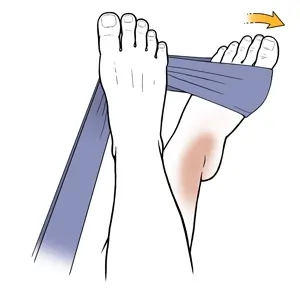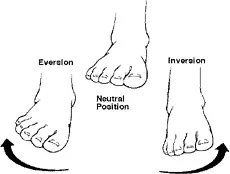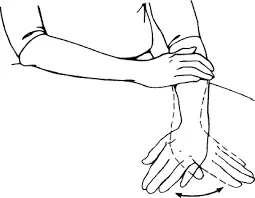Ankle Eversion
Ankle Eversion
Ankle eversion is the movement of the foot outward, away from the midline of the body. It primarily involves the activation of the peroneal muscles located on the outer side of the lower leg. This movement is essential for maintaining balance, stability, and proper foot mechanics during walking, running, and other activities.
Ankle Eversion and Inversion: What Are They?
Ankle inversion and ankle eversion are terms used to describe movements of the ankle joint. The tibia, fibula, and talus bones make up the ankle joint, which allows both dorsiflexion, lifting the foot upward, and plantarflexion, or bending the foot downward.
Ankle inversion is the moving inward of the foot sole toward the body’s midline. When the foot moves this way, its medial (inner) edge travels downward and its lateral (outer) edge rises. The muscles in the lower leg’s lateral compartment, such as the tibialis anterior, extensor hallucis longus, and extensor digitorum longus, are mostly responsible for ankle inversion. It is a typical movement performed when running, jumping, and walking.
Conversely, ankle eversion is the movement of the foot sole outward, away from the body’s midline. The lateral edge of the foot moves downward during this action, while the medial edge of the foot rises. The flexor digitorum longus and tibialis posterior, two muscles in the lower leg’s medial compartment, are the main movers in ankle eversion. Less frequently, ankle eversion happens during particular motions, including walking on uneven surfaces or participating in specific sports.
Both ankle eversion and inversion are essential for balance, stability, and normal foot function. These motions help in weight distribution during dynamic exercises and allow the foot to adjust to different surfaces. Ankle sprains or other issues may arise from excessive or uncontrolled ankle inversion or eversion, though, if the muscles, ligaments, or tendons around the ankle are weak or out of balance.
For athletes, physical therapists, and anybody else who performs activities that put a strain on the ankle joint, it is important to comprehend the biomechanics and appropriate control of ankle inversion and eversion. These motions are frequently the focus of rehabilitation programs and exercises to enhance ankle stability, avoid injuries, and support ideal foot function.
Ankle Eversion: What is It?
A specific type of movement or motion that occurs on the ankle joint is called ankle eversion. Ankle inversion is the other motion. Ankle eversion is the movement or tilting of the foot outward from the body’s midline.
The foot is a little everted in a neutral stance position, and the sole does not exactly come out. As the foot glides outward past the neutral position, ankle eversion occurs. The subtalar joint, which is situated beneath the ankle joint and allows for foot inversion and eversion, is the primary site of this motion.
Ankle eversion can occur intentionally or on purpose. It is concerned with activities that involve stepping outward, walking at the outside edge of the foot, or participating in sports requiring lateral movements.
As with ankle inversion, ankle eversion helps to maintain stability, balance, and the proper anatomy of the foot-ankle complex. The muscles responsible for ankle eversion include the peroneus longus, peroneus brevis, and peroneus tertius, which can be located on the outside of the leg. During ankle eversion, several muscle tissues work together to produce the foot’s outward motion.
Muscles of the Ankle Evertor
These muscles are located at the lateral (outer) aspect of the lower leg and are called the ankle evertor muscles. The movement of the foot away from the body’s midline, or ankle eversion, is caused by these muscle structures. Only when the foot rotates outward does eversion take place.
Some of the most important ankle evertor muscle groups are:
- Peroneus longus: The medial cuneiform bone within the foot and the main metatarsal bone are where this muscle inserts into the leg after originating from the top and upper two-thirds of the lateral fibula, the smaller of the two minor leg bones. Not only does it help with ankle eversion, but it also stabilizes the foot’s arch.
- Peroneus brevis: The bottom of the fifth metatarsal bone (the outside aspect of the foot) is where it enters after emerging from the diminished two-thirds of the lateral fibula. In most cases, ankle eversion is caused by the peroneus brevis.
When walking, running, and jumping, these muscle tissues work together to provide ankle eversion and are crucial for maintaining stability and balance. Additionally, they support the lateral aspect of the ankle, helping to prevent excessive inward rolling (inversion) of the foot, which can result in ankle sprains or other problems. Ankle rehabilitation treatments usually involve activities that target the joints and muscles.
Ankle Eversion Range of Motion
The range of mobility that the ankle may achieve when the foot starts to go outward (everted) far from the body’s midline is known as ankle eversion variations. For ankle eversion, the normal range of motion is about 20 degrees.
Ankle eversion may be measured with a goniometer, a specialized instrument for measuring joint angles. With the foot directed straight forward (0 degrees) in a neutral function, this is the dimension’s starting function. After that, the foot is pushed outward, away from the body’s midline, and the goniometer is positioned in line with both the leg’s and the foot’s long axes. This is the range of motion for ankle eversion, which is assessed by the perspective among those axes.
It is important to note that different men and women have different ranges of mobility and that beneficial factors such as past injuries, tense muscles, or joint conditions may also influence the daily variety. It is advised that you speak with a medical professional or a physical therapist if you have noticed any issues with your ankle’s range of motion. They can provide a more accurate assessment and, if required, an appropriate solution.
You can do the following actions to examine the range of ankle eversion movement:
- Locate a suitable place: To make the measurement easier, pick a comfortable, well-lit area. Ideally, you should have enough space to comfortably sit or lie down.
Take a position: With your leg out in front of you, lie down or sit on a chair awaiting your return. Be sure to have a relaxed foot and a straight knee. - Find landmarks in anatomy: Determine your leg and foot’s bone landmarks. Examine the leg to find the fibula’s apex, a bony protuberance near the outside of the knee. Find the base of the fifth metatarsal bone on the foot, which is a bony protuberance near the large toe.
- Goniometer alignment: Use a goniometer, a device that is like a protractor and is used to measure joint angles. As you align the goniometer’s midpoint with the fibula’s pinnacle, make sure that your mobile arm factors toward your foot and your desk-bound arm factors toward your knee.
- Choose the starting position: Put your foot in a neutral posture so that it points straight forward. This is taken into account while calculating ankle eversion zero levels.
- Perform the dimension: Turn your foot outward, or everted, away from your body’s midline, and move it gently and evenly. Keep the goniometer in alignment and stop when you feel a soft, silent movement or until you cannot move any farther.
- Examine the attitude: After you have reached the quit variation, look at the goniometer’s recommended attitude where the mobile arm and desk-bound arm meet. Your ankle’s range of motion for eversion is represented by this dimension.
- For accuracy, repeat: To obtain an additional accurate dimension, you can do the dimension many times and average the results.
It is important to remember that if you experience any pain or discomfort during the measurement, or if you suspect any issues with the range of motion in your ankle, you should seek professional advice from a medical professional or a physical therapist. They can provide a thorough assessment and, if required, provide appropriate guidance or treatment.
Ankle Eversion Special Test
Because the range of movement and electrical characteristics of ankle eversion may be frequently evaluated by scientific examinations and purposeful testing, there is not always a specific, one-of-a-kind check made just for ankle eversion. Together with the lateral ligaments involved in ankle eversion, there are a few special tests that might help assess the ankle’s overall balance and integrity. The following common location-specific tests are used in ankle evaluation:
Talar Tilt Test
Together with the anterior talofibular ligament (ATFL) and calcaneofibular ligament (CFL), this test evaluates the stability of the ankle’s lateral ligaments. Using both inversion (inward) and eversion (outward) pressure on the ankle joint while the foot is in a comfortable posture is what it involves.
External Rotation Stress Test:
This looks for damage to the syndesmotic (excessive ankle) ligaments. Stressing the syndesmotic ligaments, the examiner externally rotates the foot while simultaneously stabilizing the reduced leg.
The purpose of this testing is to assess for syndesmotic damage. The lower leg is squeezed by the examiner just above the ankle joint. Additionally, pain or tenderness may indicate syndesmotic ligament injury.
Single Leg Balance Test:
Standard ankle balance and proprioception are evaluated with this purposeful test. The character maintains equilibrium while standing on one leg as the examiner looks for any excessive movement or instability.
In the course of a complete evaluation, keep in mind that special tests should be performed by a certified healthcare expert, such as a physician or physical therapist. A thorough medical history, physical examination, and likely imaging studies are frequently combined with these tests to provide an accurate diagnosis and expand the appropriate treatment strategy.
Manual Muscle Testing For Ankle Eversion
MMT, or ankle manual muscle testing, is a physical examination technique used to assess the strength and functionality of the muscles around the ankle joint. Doctors and physical therapists are among the healthcare professionals who commonly use it to evaluate muscle weakness, monitor the course of therapy, or identify particular ankle problems.
Muscle testing
- Peroneus Longus
- Peroneus Brevis
Position of the patient
The posture of the patient must be comfortable.
The patient must be side-lying with the test-side ankle off the edge of the bed.
The patient is expected to be in a supine or short sitting position to evaluate grades 0–2.
Position of the Therapist
It is required that the therapist sit on a chair or stool in front of the patient.
He palpates the peroneal tendon muscle with one hand.
Apply resistance force to the dorsum and lateral foot to evaluate grades 4 and 5.
What is the test procedure?
To do ankle eversion manual muscle testing, follow these steps:
- When the patient is sitting or lying down, place their ankle in a neutral position.
- When you try to evert (turn outward) the patient’s foot while keeping the ankle joint in a neutral state, tell them to resist.
- Hold the foot with one hand while using the other to stabilize the lower leg.
- As you measure the patient’s resistance, gradually increase the force.
- Indicate the muscle’s strength on a scale of 0 to 5, where 0 indicates no contraction and 5 indicates normal strength with full range of motion.
- Do the test again on the other ankle to compare.
- When necessary, include your findings in the patient’s treatment plan and record them.
It is crucial to keep in mind that manual muscle testing should only be performed by trained medical professionals who have been properly trained and educated. Furthermore, before examining a patient, it is crucial to take note of any contraindications or precautions.
Take Precaution
- Before beginning the test, make sure the patient is at ease and calm.
- Before the test begins, go over the process with the patient.
- To keep the patient safe, do not use too much force throughout the test.
- Avoid putting excess pressure on your muscles by using good body mechanics.
- Avoid performing the test on a patient who is experiencing unbearable discomfort or an acute ankle injury.
- If the patient feels any pain or discomfort, stop the test right once.
- Before performing the test, always do a comprehensive evaluation of the patient’s medical history and present state.
Ankle Eversion Exercise
Improving ankle balance and preventing injuries can be achieved by strengthening the ankle evertor muscle tissues. Ankle evertor muscle tissues are the focus of this exercise:
Ankle Eversion with Resistance Band:

- While seated on a bench or chair, place a resistance band around your forefoot. The resistance band’s ends should be held in your hands.
- Maintain a 90-degree bend in your knee and a foot that is only slightly off the ground.
- Start in a neutral position with your feet together.
- Push your foot outward against the resistance bands, from your body’s midline, slowly and carefully.
- After a few seconds of holding the give-up function, return to the beginning function in a controlled way.
- Ten to fifteen repetitions should be performed.
- Complete two to three sets of this exercise.
Be sure you select a resistance band with the right suitable tension. Changing the problem can be achieved by using a band with a higher or lower resistance.
Furthermore, adding exercises that focus on the muscles of the lower leg, such as calf raises and ankle dorsiflexion exercises, can provide the ankle joint with normal strength and balance. For optimal balance and function, it is important to maintain a balanced exercise regimen that includes strengthening exercises for all ankle joint muscles.
It is advised to see a healthcare professional or a qualified exercise specialist, such as a physical therapist, before starting any exercise program to make sure that the physical activities are appropriate for your individual needs and preferences. They may provide guidance on the appropriate form, advancement, and other necessary modifications based on your special conditions.
FAQs
What muscles do ankle eversion?
The two muscles responsible for plantarflexion and eversion of the foot, the peroneus longus, and the peroneus brevis, make up the lateral compartment.
What are the benefits of eversion?
Lying on the back with the legs straight, inversion, and eversion involves shifting each foot as far up toward the torso as you can while alternating between inverting and everting each foot. This exercise corrects hip, knee, and ankle incorrect alignment, increases range of motion and control, and relieves discomfort.
How to strengthen peroneal muscles?
Your affected leg should be crossed over your other knee when you sit on a chair.
To slowly tilt your foot toward the floor, hold the bottom of your foot. For 5 to 10 seconds, hold.
With your foot tilted toward the ceiling, draw it toward you. For 5 to 10 seconds, hold.
Ten times over, repeat.
Is walking good for ankle strength?
Start on your heel, move your foot forward, then raise yourself up onto your toes with each stride. Stability improves and the muscles supporting the ankle are strengthened as a result.
What is the best exercise for ankle pain?
Lift your foot to 20 inches off the ground. While keeping your toe up, rotate your foot to the left and then back to the right. Return to the starting position after ten seconds of holding. Do this 20 times per leg.
Do squats help strengthen ankles?
To increase your ankle range of motion, you can do weighted lunges, squats, or split squats 2-4 times a week for 2-4 sets of 30-60 second holds or 6-12 repetitions holding at your end range for three to five seconds.
References:
- Patel, D. (2023, July 13). Ankle inversion and ankle eversion – movement, ROM, muscles. Samarpan Physiotherapy Clinic. https://samarpanphysioclinic.com/ankle-inversion-and-ankle-eversion/
- Patel, D. (2023a, May 29). Manual Muscle Testing of Ankle(MMT of Ankle Muscle) – Samarpan. Samarpan Physiotherapy Clinic. https://samarpanphysioclinic.com/manual-muscle-testing-of-ankle/#Ankle_eversion







